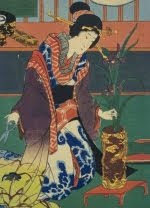Modern basket ikebana. Calla lily, pine and bamboo stick.
You'll find woven baskets and other objects in most cultures. By using and old cane chair seat as an ikebana basket this arrangement gives new life to a woven object from a western culture. Doing so it is honoring an old crafts tradition. At the same time this odd ikebana basket is suggesting a kinship of crafts around the world using plant materials for weaving. Life is full of new opportunities - and you always have to work with what you have.
The flowers in this ikebana are a bit heavy for the basket, but with the space created by the curved line of the bamboo stick there is enough volume to get a balance.
The flowers in this ikebana are a bit heavy for the basket, but with the space created by the curved line of the bamboo stick there is enough volume to get a balance.











